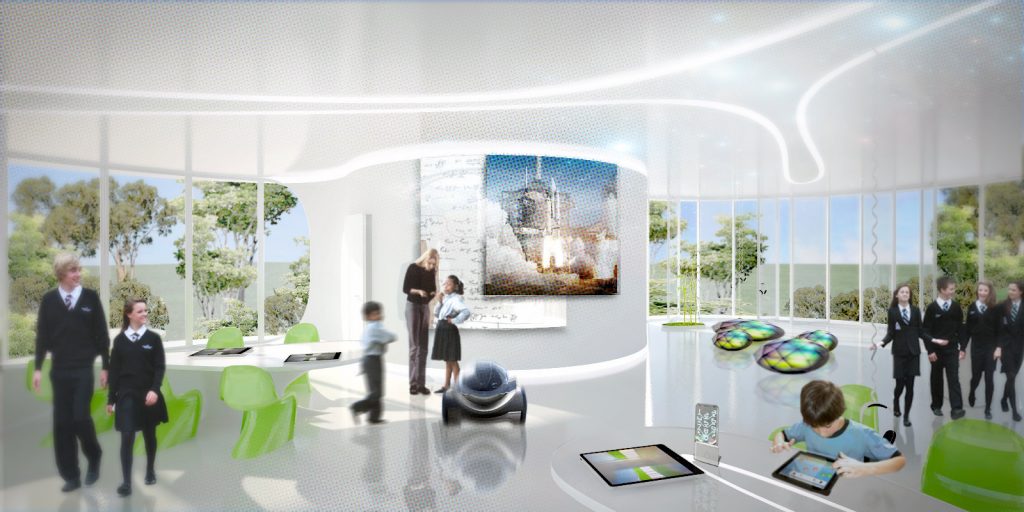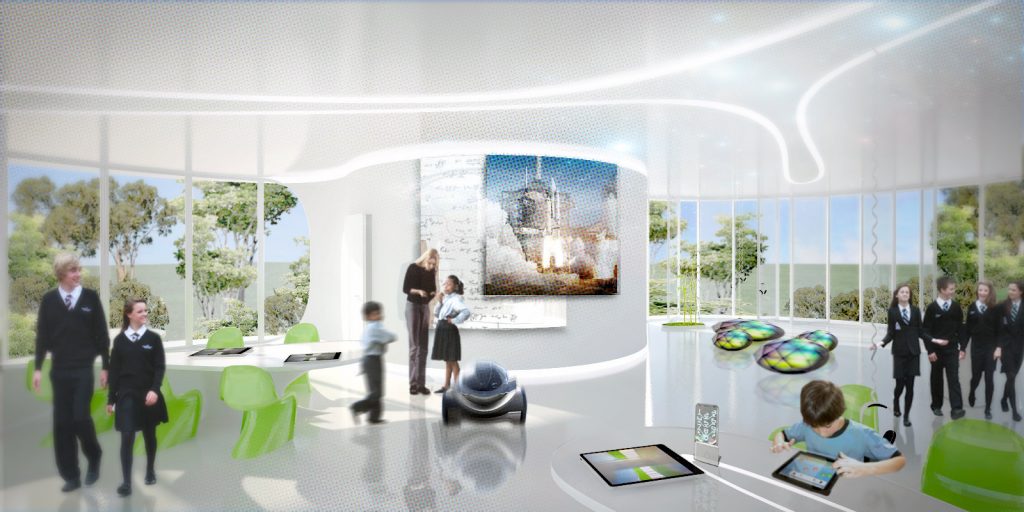Technology encompasses so much more than just electronics and other digital assets. Architecture or social structures are in fact technologies – an application of knowledge for practical means.
Just as the world is rapidly shifting so are the ways in which we experience physical environments and interact with peers and teachers. The traditional ‘classroom’ is immensely far behind in this technological evolution and restructuring the ‘classroom’ is a major opportunity. The design of traditional classrooms lack the ability to fully realize the potential of educational technologies.
When kindergarten was designed children were made to sit at desks spaced out in a grid and instructed how to play. Such a layout is unimaginable now compared to a more organic classroom with open-ended activities. So too in our higher level classes the structure must change. Especially as more and more, with the advent and adoption of online tools, the teacher is not the holder of the knowledge.
Makerspaces and startup ‘incubators’ have proven to be immensely successful structures for learning and creation – could a school take key components from these?
Opportunity Statement:
Classrooms, schools, and the social structure within them has an enormous opportunity and necessity to pivot in order to cater to the 21st century student.
Sources:
Designing the classroom to match 21st century teaching
What should school teachers be like in the year 2030?


I like this post because you are thinking outside the box of “educational technology.” I also think the role of technology is meant to be a supplement to a learning environment’s physical space and culture. Your post also made me think about how highly innovative companies (e.g. Google) have done the same.
I feel that by default, this topic need to be relevant to me. Because I work in education, I want to keep up with emerging technologies as well as the potential technologies that will transform the classroom to enrich learning and create learning spaces where deep learning experiences can occur.
The picture attached to this post resonated with me and was eye candy for brainstorming. The physical space and organization of a classroom feels as if it hasn’t changed much (or at least when I was in school). Although some may say not to fix what isn’t broken, I can’t help but dream of what my ideal classroom would look like, and when I think of it that way, I know educational technology plays a large part of this dream.
Changing the layout of the classroom to be more organic and open-ended seems more and more possible with technological advances. The only question I ask is when school systems will give the green light on this flexibility?
Conceptually this is a great post since we often neglect the physical spaces of the classroom. We tend to focus too much on the curriculum and ignore the fact that physical layout/construction of a classroom is equally important to the learning experience.
Classrooms need to be built to accommodate and support student needs, perhaps the traditional approach of “facing the teacher”/chalk and talk layout is ineffective as we need classrooms to be designed to encourage and allow for interactivity to occur, places where students can learn from each other and having a space which reflects the overall mission of what you’re trying to teach
Despite all the yo-yoing in and out of the classroom over the course of the pandemic, classrooms are certainly here to stay. In what capacity remains to be seen. During the course of my career working in the design industry, I’ve had the opportunity to design and build some so-called “classrooms of the future.” Active learning classrooms where everything moves (even the plugs!), gallery demonstration spaces with 3d creation machines, lecture halls with arsenals of tech, etc. Funnily enough, most of this work occurred before I did any teaching! I feel like I’d do a better job nowadays…
In the past, a “classroom of the future” was generally lauded as either 1. technology rich or 2. extremely flexible (and if you want to spend a lot, you can do both!) With the “assumed” shift from virtual learning to physical learning as an extension of a “return to normal,” I am genuinely curious to see how the duality of technology-friendly virtual learning and inflexible physical learning spaces are going to work together. More than ever, they NEED to.
Creating the classroom of the future involves not only looking at how schools should be now, but also trying to anticipate what they should be like in the years to come. Schools need to be more than just a space for desks and learning technologies, they need to be designed with all of the students’ needs in mind: social, emotional, physical, as well as academic. Schools and classrooms should be a place where students feel comfortable and welcome and where they can learn skills necessary to be successful in life.
This post was one of the first to catch my eye. Out of all these technologies discussed I think a transformative classroom is one of the best ways to impact the way learners experience their education. Just like there are a wide range of learners and learning styles, there should be a fluidity as to how classrooms are laid out. The problem is that most school infrastructure is pushing 40-60 years old. How you redesign an existing space so that you can incorporate even a few of these ideas. How do you change an existing institutionalized layout where the plugs are in the wall and the screen is on the other wall and don’t forget, things should be hard surfaced so they are wipeable. Students should walk into a room and feel motivated, engaged and energized, but the reality is that most rooms leave students staring at the analog clock on the wall.
Another aspect of the learning environment we must consider is its importance as a place to stage communities of inquiry, and how those physical environments encapsulate the ever-changing digital ones that support and broaden learning opportunities? As we begin to refine learning theories for the 21st century, create curriculum that is representative of the needs of the time (goodbye industrialization-era education), and include relevant and meaningful digital tools, we also need to be thinking about how the physical learning environment fits into this. Are we creating spaces for students to work asynchronously on assignments provided by their teacher to potentially incorporate the benefits of the “flipped classroom” ( https://www.edutopia.org/article/making-your-flipped-classroom-more-human )? Or just ensuring there are mixed use spaces available in every school, such as maker spaces. Perhaps, this is an opportunity to review the format of school; post pandemic? Do we need our students in front of a teacher for 6+ hours a day, or have we reached an age-appropriate place where students have time with the teacher, and time for asynchronous work included within the structure of their day?